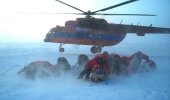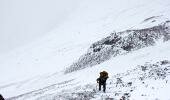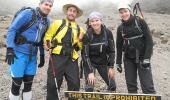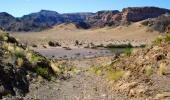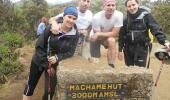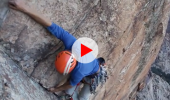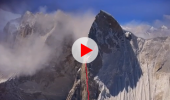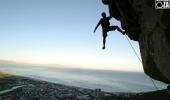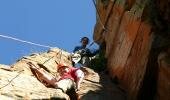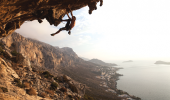Words: Matthew Holt | Photos: Matthew Holt & Mandy Ramsden
The taxi sashayed exuberantly around the bends to the radio music, trucks flashed past in the opposite direction and memorials lined both sides of the road. We were unmistakably in Venezuela, where every taxi ride might be your last trip. Mandy Ramsden and I had come to climb Pico Bolivar, the country’s high point at 4,978 m. It was becoming an annual excursion. On our first foray, during the supposed dry season in 2011, we’d spent four days at the base of the peak watching rain and rock fall until we ran out of food and went home.
The following year, a family bereavement thwarted us just before we boarded the plane. And now, on our third attempt, we’d made the cardinal error of preceding mountaineering with pleasure, by holidaying in Cuba and savouring seafood at every meal. It was only after touching down in Caracas and racing for the bathroom that we learned of the cholera epidemic gripping Havana. Exotic foreign culture is all well and good, till it settles in your intestines.
In case you’re wondering what was so compelling about this obscure Venezuelan peak; well, mountains are like women, and the more they rebuff you, the more you must have them. Then again, Mandy might feel differently and even my ardour was being severely tested by these constant rebuffs. Indeed, this time I feared the worst, associating cholera with plague ships and mass graves. Fortunately, our Venezuelan host, Pablo, was less melodramatic and rustled up a doctor who prescribed antibiotics and lurid drinks. Thus resurrected, we proceeded on to Merida, situated at the foot of Venezuela’s highest peaks, the so-called ‘white eagles’.
Despite its uplifting setting, the university town was in an edgy mood, as the country was in even worse shape than us. The president had been missing for two months (some said he was recuperating from an operation, while others said he was dead), the students were demonstrating and barricading the streets (though thankfully only when they got up after noon) and the economy was collapsing (with the black market offering four times the official exchange rate). So, after one day in Merida finalising provisions, we were pleased to head off to our mountain.
Originally called the Column, this jagged granite spire was renamed in honour of Venezuela’s greatest son, Simon Bolivar - a.k.a. ‘the Liberator’ - who in the early 19th century criss-crossed the Andes with a ragtag army, driving the Spanish off the continent. Until recently, climbing it was a relatively civilised affair, courtesy of the world’s longest and highest cable car, which whooshed punters up from Merida to the neighbouring Pico Espejo, from where it was a leisurely two-day return outing. The logistics became more complicated after 2008, however, when the cable car collapsed.
Our trip was arranged by Pablos Borjas von Bach, whose name evoked arch-dukedoms and castles, rather than squalid mountain bivvies. Nonetheless, he was a leading Venezuelan mountain guide, and his birdsong voice and jockey’s physique disguised an unflappable nature and Herculean strength. Completing our party was a Merida-based guide nicknamed ‘Rebaquito’, who had a wrestler’s build and huge sombrero.
It was a jolting four-hour jeep ride from Merida up to the hamlet of Los Nevados, some 10 km to the south of Pico Bolivar. On a continent that prides itself on deadly mountain roads, this was right up there, a rough dirt track scratched into the mountain, with a precipitous, unprotected drop into a river gorge, several hundred metres below. Barely wide enough for one vehicle, complications inevitably arose when we encountered oncoming traffic. And given the local culture, neither male driver could find it within himself to cede ground. So, after a bristling, inconclusive stand-off, they would edge round each other like lovers performing a slow, sultry dance, the outer wheels spinning dangerously over the void.
Perched in the mountains at 2,700 m, Los Nevados comprised an elegant church, tidy square and handful of simple houses and basic posadas (guest houses). We spent a peaceful afternoon playing petanque and watching zamuros, a slightly smaller version of the Andean condor. On the deck, they were ungainly creatures - like a cross between a vulture and turkey - but once airborne, they were pure grace, effortlessly sailing and soaring on thermals.
The next morning, we set off up the valley on foot. Soon, the sun was blazing down, lighting up the paramo flora of giant heathers and espeletia flowers, which might have been a boon for botanists, but was a bane for unconditioned mountaineers. Fortunately, most of our gear was loaded on two mules that truculently ascended the steep trail, driven on by their arriero. Reaching the top of the pass at 4,000 m, we turned right along the ridge on a petering trail until the mules finally rebelled and the arriero could drive them no further. After they’d deposited our gear and departed, we pitched our tents on a small terrace overlooking the disused cable car station at Loma Redonda.
The next day we continued up the ridge, now fully laden ourselves. Mountaineering is a very different sport when you subtract the mules, yaks and porters. Any thoughts of complaint were stifled, however, by the sight of Pablo gamely shouldering a rucksack far bigger than mine and Rebaquito cheerily hoisting on a pack far bigger than Mandy. It took us over four hours to reach Laguna la Sangre (‘blood lake’), a rather dramatic name for a small green pond at 4,600 m. Our plan was to camp here and strike for the summit the following day, which would make for a long return trip, but avoid us having to lug our camping gear any higher. As such, it seemed like a brilliant idea.
Rising at 5 a.m., after a sleepless night tossing, turning and tucking into a foetal position to no avail, my head still throbbed with the altitude. Pablo and Rebaquito already had the stove fired up and were preparing ham and cheese paninis, which they proudly presented as if hosting Come Dine With Me. I diplomatically waited till their backs were turned before tossing mine behind a boulder. It was still dark and cold when we left camp under headlamps, but by the time we broached the col, an orange sun was poking through the carpet of clouds. Though I loathe alpine starts, I’ll admit there are compensations. Traversing left beneath Pico Espejo, we picked our way through the rock bands to Timoncitos, a small mirror lake suspended in a hanging amphitheatre at 4,700 m. Two years earlier, when we’d spent four days here forlornly waiting for the weather to clear, it had been a bleak, hostile place. Now, in the warming sunshine, it was almost welcoming.
Towering above us, a curved wall of fractured granite rose 250 m up to Pico Bolivar’s summit. As with most matters Venezuelan, there was disagreement on who had trodden there first. Some sources credited the local trio of Enrique Bourgoin, Heriberto Marquez and Domingo Pena (wearing sandals), who in January 1935 climbed the couloir to our right. Others implied they’d stopped just short, championing instead a German-born doctor, Franz Weiss, who one year later ascended the gully to our left. Without wishing to take sides, we chose Weiss’s line, which is now the standard route.
It started well enough, up a series of solid rock steps leading into La Canaleta (‘the gutter’). There are canaletas on several South American peaks that are invariably loose, steep and unpleasant, but this was far worse: a narrow chute choked with scree, primed to collapse and demanding gymnastic moves to surmount large, wobbly chock stones. By now, we were feeling sufficiently vulnerable to rope up and put helmets on. Next came a moderately angled boulder field named after the neighbouring province, Táchira. It must have been meant as an insult since this was the most treacherous section by far, a shattered jigsaw of broken rocks that gave way under every step. Clawing our way up, we gratefully reached La Ventana (‘the window’), which looked like a missing tooth, but was in fact the key to the route.
Though the summit was now only 50 m higher to our right, at first sight it appeared unattainable, protected by a blank, vertical wall. At this juncture, however, Pablo slipped through the window, stepping out onto a narrow ledge on the other side. We edged after him, along a straightforward, if airy traverse, with Bolivar’s north-west face peeling away beneath our toes. A few graceless hoiks up a chimney and we were on the summit, marked by a bust of Simon Bolivar. This lofty, lonely spot seemed a fitting tribute to the Liberator. After his heroics driving out the Spanish, he then unsuccessfully tried to weld the region into one united country, under his rule. Having narrowly escaped an assassination attempt, he died of tuberculosis, aged 47, just before quitting South America. Shortly before his death, he wrote, ‘The three greatest fools in history have been Jesus Christ, Don Quixote and me.’ Clinging to his bust on the small, exposed summit, we joined Rebaquito in the traditional Venezuelan victory cry of ‘Cumbre!’ It had taken us five hours from camp to the top.
The descent was sketchy. And the more caution we took, the sketchier it got. We tried down climbing, but that was fraught since the lead climber got constantly showered with rubble. And we tried abseiling, but that was even worse. As Pablo rappelled through Táchira, the rope dislodged a boulder the size of a television, which gathered momentum and went bouncing straight at him. While the rest of us watched horrified from above, Pablo coolly stood his ground like a matador facing a charging bull and then shimmied right at the last moment so it brushed past his right leg. We were most impressed; till he later admitted that he’d tried dodging left and right, but on failing to get any purchase had resigned his fate to the gods. Down climbing, abseiling, slithering on butts, we somehow made it back to camp unscathed, barring Pablo’s pants, which required some tailoring.
It took two more days to hike out via Loma Redonda to Mucunutan, where a jeep picked us up. When we got back to Merida, little had changed. The president was still missing (recuperating or dead), the students were still demonstrating (in the afternoon) and a pizza plus beer was exorbitant (unless you risked the black market). We’d changed, however, and definitely for the better. Though we still had a couple of taxi rides to chance, we were finally free from the Liberator.
dinFO:
• Climbing Pico Bolivar currently involves a six to seven day return trip from Merida. The cable car is officially scheduled to reopen in 2013, potentially reducing this to a couple of days, provided you’re acclimatised.
• The standard Weiss route involves 250 m of scrambling and easy rock climbing (up to SA grade 9-10). However, the route is prone to rock fall.
• Huellas (www.huellasaventuras.com.ve) can arrange guided trips, costing approximately US$2 000 per person.
